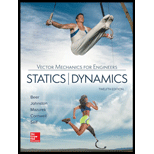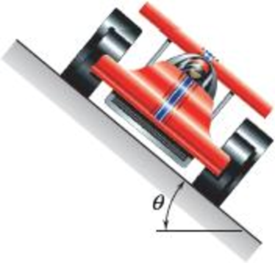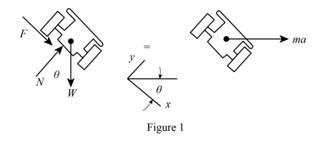
Concept explainers
A curve in a speed track has a radius of 1000 ft and a rated speed of 120 mi/h. (See Sample Prob. 12.7 for the definition of rated speed.) Knowing that a racing car starts skidding on the curve when traveling at a speed of 180 mi/h, determine (a) the banking angle θ, (b) the coefficient of static friction between the tires and the track under the prevailing conditions, (c) the minimum speed at which the same car could negotiate the curve.
Fig. P12.52

(a)
Find the banking angle
Answer to Problem 12.52P
The banking angle
Explanation of Solution
Given information:
The radius
The rated speed
The frictional force
The speed (v) at prevailing condition is 180 mi/h.
Calculation:
Write the general equation weight (W).
Here, m is the mass and g is the acceleration due to gravity.
Write the general equation of acceleration (a) in curved path.
Here, v is the speed and
Sketch the free body diagram and kinetic diagram of the racing car as shown in Figure (1).

Refer Figure (1):
Consider the racing car moves at rated speed.
Find the banking angle
Apply Newton’s law of equation along x-axis.
Substitute 0 for
Substitute 120 mi/h for
Thus, the banking angle
(b)
Find the coefficient of static friction between the tires and the track under the prevailing conditions.
Answer to Problem 12.52P
The coefficient of static friction between the tires and the track under the prevailing conditions is
Explanation of Solution
Calculation:
Refer Figure (1):
Consider the racing car moves in prevailing condition.
Apply Newton’s law of equation along y-axis.
Substitute
Apply Newton’s law of equation along y-axis.
Substitute
Find the coefficient of static friction
Write the general equation of normal force(N).
Substitute Equation (1) and (2) in Equation (3).
Substitute 180 mi/h for v,
Thus, the coefficient of static friction between the tires and the track under the prevailing conditions is
(c)
Find the minimum speed at which the same car could negotiate that curve.
Answer to Problem 12.52P
The minimum speed at which the same car could negotiate that curve is
Explanation of Solution
Calculation:
Write the general equation of normal force (N) in minimum speed.
Substitute Equation (1) and (2) in Equation (3).
Substitute 0.390 for
Thus, the minimum speed at which the same car could negotiate that curve is
Want to see more full solutions like this?
Chapter 12 Solutions
Vector Mechanics for Engineers: Statics and Dynamics
- An automobile weighing 4000 lb is driven down a 5° incline at a speed of 60 mih when the brakes are applied, causing a constant total braking force (applied by the road on the tires) of 1500 Ib. Determine the time required for the automobile to come to a stop.arrow_forwardRequired information A uniform thin bar AB of length L = 5.5 ft is released from rest at an angle 0 = 0₁. As the bar slides, the ends A and B maintain contact with the surfaces on which they slide. A L B Neglecting friction and knowing that the end A has a speed of 18 ft/s right before hitting the floor, determine 0₁. The value of 0₁ isarrow_forwardapplied mechanics 2arrow_forward
- Knowing that the coefficient of static friction between the tires and the road is 0.80 for the automobile shown, determine the maximum possible acceleration on a level road, assuming rear- wheel drive 20 in. 60 in. 40 in.arrow_forward3. A small block B fits inside a lot cut in arm OA which rotates in a vertical plane at a constant rate. The block remains in contact with the end of the slot closest to A and its speed is 1.4 m/s for 0< 0 <150°. Knowing that the block begins to slide when 0 = 150°, determine the coefficient of static friction between the block and the slot. V = 0.3 m Aarrow_forwardDetermine the maximum theoretical speed that may be achieved over a distance of 70 m by a car starting from rest, knowing that the coefficient of static friction is 0.80 between the tires and the pavement and that 60 percent of the weight of the car is distributed over its front wheels and 40 percent over its rear wheels. Assume a four-wheel drive car. The maximum theoretical speed that may be achieved is ____ km/h.arrow_forward
- Two blocks having the weights and position shown, rest on a frame which rotates about its vertical axis at a constant speed. The coefficient of friction between the blocks and the frame is 0.02 neglecting the weight and friction of the pulley, at what speed in RPM will the blocks start to slide? What is the tension in the cord at this instant.?arrow_forwardapplied mechanics 2arrow_forwardapplied mechanics 2arrow_forward
- A 1500-kg automobile starts from rest at point A on a 6° incline and coasts through a distance of 150 m to point B. The brakes are then applied, causing the automobile to come to a stop at point C, 20 m from B. Knowing that slipping is impending during the braking period and neglecting air resistance and rolling resistance, determine (a) the speed of the automobile at point B, (b) the coefficient of static friction between the tires and the road. 150arrow_forwardIf an automobile’s braking distance from 90 km/h is 45 m on level pavement, determine the automobile’s braking distance from 90 km/h when it is (a) going up a 5° incline, (b) going down a 3-percent incline. Assume the braking force is independent of grade.arrow_forwardRequired information NOTE: This is a multi-part question. Once an answer is submitted, you will be unable to return to this part. A 2000-kg automobile starts from rest at point A on a 6° incline and coasts through a distance of 67 m to point B. The brakes are then applied, causing the automobile to come to a stop at point C, 20 m from B. 20 m АB m 6° A В Knowing that slipping is impending during the braking period and neglecting air resistance and rolling resistance, determine the speed of the automobile at point B. The speed of the automobile at point B is m/s.arrow_forward
 Elements Of ElectromagneticsMechanical EngineeringISBN:9780190698614Author:Sadiku, Matthew N. O.Publisher:Oxford University Press
Elements Of ElectromagneticsMechanical EngineeringISBN:9780190698614Author:Sadiku, Matthew N. O.Publisher:Oxford University Press Mechanics of Materials (10th Edition)Mechanical EngineeringISBN:9780134319650Author:Russell C. HibbelerPublisher:PEARSON
Mechanics of Materials (10th Edition)Mechanical EngineeringISBN:9780134319650Author:Russell C. HibbelerPublisher:PEARSON Thermodynamics: An Engineering ApproachMechanical EngineeringISBN:9781259822674Author:Yunus A. Cengel Dr., Michael A. BolesPublisher:McGraw-Hill Education
Thermodynamics: An Engineering ApproachMechanical EngineeringISBN:9781259822674Author:Yunus A. Cengel Dr., Michael A. BolesPublisher:McGraw-Hill Education Control Systems EngineeringMechanical EngineeringISBN:9781118170519Author:Norman S. NisePublisher:WILEY
Control Systems EngineeringMechanical EngineeringISBN:9781118170519Author:Norman S. NisePublisher:WILEY Mechanics of Materials (MindTap Course List)Mechanical EngineeringISBN:9781337093347Author:Barry J. Goodno, James M. GerePublisher:Cengage Learning
Mechanics of Materials (MindTap Course List)Mechanical EngineeringISBN:9781337093347Author:Barry J. Goodno, James M. GerePublisher:Cengage Learning Engineering Mechanics: StaticsMechanical EngineeringISBN:9781118807330Author:James L. Meriam, L. G. Kraige, J. N. BoltonPublisher:WILEY
Engineering Mechanics: StaticsMechanical EngineeringISBN:9781118807330Author:James L. Meriam, L. G. Kraige, J. N. BoltonPublisher:WILEY





